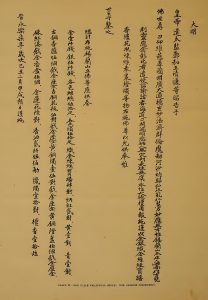
Galle (Sri Lanka). Stele of Zheng He (鄭和), transcription of Chinese portion. (Zenodo).
The inscription is engraved on a stone slab discovered in 1911 by H. F. Tomalin, the Provincial Engineer at Galle, in a culvert near the turn to Cripps Road within that town and afterwards moved to the Colombo Museum. The slab features inscriptions in three different languages, enclosed within a floral border: Tamil (top-left, IN03150), Persian (bottom-left, IN03151) and Chinese (right). The Chinese inscription is dealt with here.
Following the discovery of the slab, the Chinese inscription was transcribed and translated by Edmund Backhouse. Like the Tamil inscription, it is dated in the second month of the seventh year of Yongle (永樂), the Chinese emperor whose reign began in 1403. The text features praise and offerings dedicated by the Chinese emperor, through his envoys Ching-Ho and Wang Ch’ing Lien, to the Buddha. The other two inscriptions on the slab feature similar lists of offerings but the beneficiary is different in each case, being a Hindu cult deity in the Tamil text and an Islamic saint or shrine in the Persian. It therefore appears that, when the Chinese arrived in Sri Lanka, they made gifts of equal value to several different religious traditions of the region and registered these gifts on the same stele.
In 1913, Edward W. Perera contributed a paper on the trilingual slab to the Spolia Zeylanica (vol. viii, pp. 122ff.), which included an account of its discovery and its historical importance, together with the text and translation of the Chinese inscription by Edmund Backhouse. Backhouse’s translation was republished as an appendix to Senarath Paranavitana’s account of the Tamil inscription in Epigraphia Zeylanica 3 (1928–33): 331–341, no. 36, Appendix A.